ـ
شجر الخرز يباع بسعر خيالي
يمكنك صنعها بكل بساطة
الصور تشرح الطريقة بالتفصيل
ولن تحتاجي للترجمة
وعملها من ثلاثة مراحل
المرحلة الأولى عمل الفروع
شجر الخرز يباع بسعر خيالي
يمكنك صنعها بكل بساطة
الصور تشرح الطريقة بالتفصيل
ولن تحتاجي للترجمة
وعملها من ثلاثة مراحل
المرحلة الأولى عمل الفروع
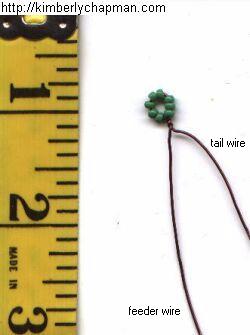 d d | To start a branch, give yourself a nice long tail of about six to eight inches, then make a loop and twist it closed. The number of beads in the loop will vary with the type of tree; use more for longer "leaves," less for more "bud-like" trees. In this case, I've used eight beads, which I've found is a good medium. The "feeder wire" is the wire still attached to the spool, with the long string of beads on it. The "tail wire" is the loose end with no beads on it. |
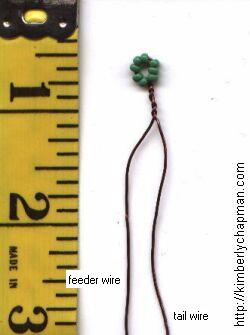 d d | Twist down from the loop for about half an inch, or centimetre or two. See my tips on twisting wire if you're concerned that you're not getting good twists. |
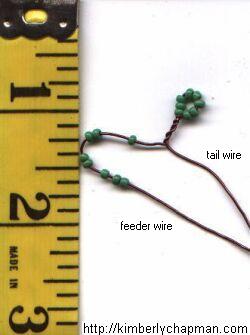 d d | From your feeder wire, move up another eight beads. Make a bend in the wire about equal to the full length of the previous twisted part. It doesn't have to be exact; in fact, keep in mind that natural trees have a great deal of variance in branch length. |
 d d | Pinch the feeder wire against the original branch to hold it, and then twist the new loop closed. |
 d d | Continue twisting the new loop until it is uniformly snug against the original. |
 d d | Feed up another eight beads. |
 d d | As above, form a new loop and twist it closed against the other branches. |
 d d | Now twist the feeder wire together with the tail wire for about half an inch. Again, this does not have to be exact. You've now learned the basic building block of a branch! The rest of the branches will be extensions and variations on this format. And if your thumbs aren't sore yet, they will be! *grin* |
 d d | To make a whole new segment of branch that can have several loops off of it, start with a section of wire roughly the length of the previous assembly. It doesn't have to be exact. Feed up eight more beads. |
 d d | Twist off this first loop, but not all the way down. Just go about a half-inch again. Then feed in another eight beads. |
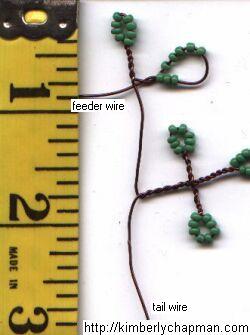 d d | As with the previous assembly, form a loop to the side with the beads, then close it up by twisting. |
 d d | Add another branch to the other side, just as before. |
 d d | Twist down the feeder with the remaining wire between the branch segments. |
 d d | Then twist down along the tail wire a bit more. |
 d d | If you're using soft wire, you'll probably have to stop here to prevent drooping. However, if your wire feels like it can support more weight, you can add more segments. In this example, I'm making a large segment by leaving about three inches from the last segment to the new loop. |
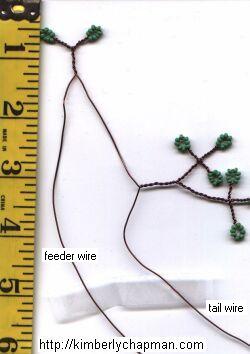 d d | Here I've added a segment of two instead of three, and twisted down about a half inch. It's a good idea to vary the number in the segments to get a more "natural" look. (Ignore the tape, it's just there to hold the wire for scanning.) |
 d d | I've then added a three-part segment, made just like the ones above. |
 d d | To give the branch a built-in kink and add variety, I've added a single short segment. I often do this if I've started to make a multi-part segment and then decided mid-twist that I haven't left enough slack wire to do so. |
 d d | Here I've added a four-part segment, which is made exactly the same as a three-part one, only instead of twisting down after the third branch, you go ahead and add a fourth. |
 d d | After twisting down, sometimes you'll find you have a gap left. To fix this, just give one or both branches another twist. In the picture below, you can see that that gap is gone and the segment has been rotated. |
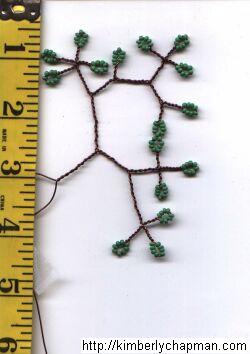 d d | Join it all together by twisting down the tail wire again. |
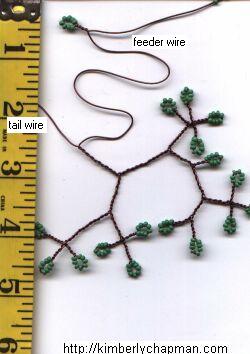 d d | Because this stiff wire can still support more weight (tested by holding it out and shaking it and seeing if it bends much), I'll add another chunk. This time I've left a gap of about five inches. It's curved together to compact it for scanning, but otherwise would be kept straight while working. It's around this point that your feeder wire will fall in love with your loops, and try to entangle with them. Such scurrilous behaviour should be discouraged by positioning your feeder spool to one side and the part you've already done to the other, keeping the current working area in the middle. Inevitably, though, that trampy little feeder wire will snag a loop or branch from time to time. Just pause and untangle it before it gets kinky...I mean, kinked. *grin* |
 d d | Here's a completed branch with many segments. It's been finished by twisting the feeder wire all the way down the tail wire, which is important for strength of the whole branch. I've squished parts of it together to fit in the scan field, but that's not a problem since you'll eventually be bending the bits to arrange them anyway. After all, not many trees look flat! |

المرحلة الثانية ضم الفروع إلى بعضها وعمل جسم الشجرة أي ساقها
 d d | When you have several branches, start twisting some of them together as shown. Leave a gap between the bottom segments and the point where you begin twisting. The gap should be enough to look like "natural" branch growth, but not so long as to be prone to drooping. Twist all the way down to the ends. If one is longer than the other, that's fine. Don't trim any tails, as they're all good for added stability in the final assembly. |
 d d | This graphic shows a simple branching system, where you take two branches and combine them as above, then do that with two others, and then combine those two groups of two, etc. This yields a very uniform style of tree, which is appropriate for some trees. It's also easier to keep track of, and may be best for the beginner who is orderly about such things. Below is another style. |
 d d | This is a more complex and random branching system. Branches are combined in different numbering groups, and some are added midway along without partners on the opposite side. This yields a generally more "natural" style that fits most trees. It is more forgiving in terms of varying lengths and numbers of segments, but requires a bit more forethought in making sure there aren't any big bare spots in the final assembly (although more branches can always be added). It's probably best for the beginner who doesn't like to have to worry about keeping track of what bits match or not. It is my preferred style. |
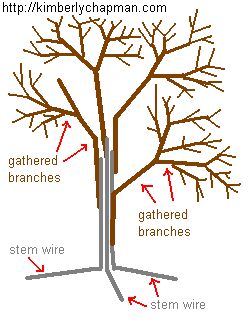 d d | Regardless of your branch assembly style, you should eventually have combined your branches down to a main few, depending on the tree type. To bind them together and form the trunk, hold the branches in your hand and decide which should form the crown of the tree, and which would look good sticking out from the side, if any. To thicken and strengthen the trunk, add in some stem wire as well. As shown in the diagram, arrange the branches and stem wires so the stem wires will stick out like roots at the bottom (this will be important for anchoring the tree later), and the branches poke out from the top and sides. Give yourself plenty of spare branch length to feed into the trunk so that they won't fall out. You may want to further twist some of them together, but do NOT twist the stem wires together with the branch ends unless you want to have a very knobbly-looking trunk, which is also harder to cover with wire. I recommend going with a straight trunk for your first tree. Use at least three stem wire "roots," four is better. |
 d d | Secure the branches and stem wire together using floral tape of an appropriate colour. If you can only find green, that's okay, because it'll be covered with wire anyway. It's just more forgiving if the colour matches, because you don't have to worry for the occasional spot that shows through. The diagram shows the tape very loose and with big gaps. That's just for demonstration purposes. You should tape it very snugly and thoroughly, starting from a top branch and gradually combining other branches in. Don't just wrap all the branches together at once for most trees, since few real trees grow that way. Tape all the way down to the bottom, leaving the bent bits of stem wire exposed. |
 d d | This diagram shows more or less what the taped trunk should look like. Of course, your branches will vary. |
 d d | Next, you'll wrap wire around the taped portion. The diagram shows it as a different colour only for clearer demonstration. You want this to be the same colour as your branch wire or it'll look weird. This is why you need a big spool of the wire, because this is going to use up a lot. The diagram shows it loose and only partway down just as a demonstration of how to start with one branch and follow the path of the tape, gradually wiring in more branches. You should actually do it very snugly, and taking it slowly to try to get the wire lines against each other instead of crossing. This should give you a nice covering. If you cross back and forth often, it won't look as nice. See the tips on twisting wire for diagrams. If your trunk is going to be significantly curved, you should use pliers to put those curves in before doing the wiring. Otherwise, the wiring may bunch up or gap on the curves. |

المرحلة الثالثة تثبيت الشجرة في الإناء الخزفي وإعطاءها شكلها النهائي
.
 d d | To attach the tree to a wooden base, spread out the "roots" (the stem wire bits poking out from the bottom) in such a way that the tree sort of balances naturally on its own. This might take a lot of bending things around to get it right. You want the bottom of the wire-wrapped bit as flush against the base as possible. When you're happy with the balance, trim the stem wire so that it doesn't hang off the ends of the base. In fact, if you want some of the wood base to be shown, cut the "roots" back far enough to allow that. Place the tree where you want it, and use a staple gun, pushing down hard, to staple down the roots. Do it in several locations for maximum stability. When you're done, the tree should not shift around if you pick up the whole thing and give it a little shake. If the staples won't go in far enough on their own to hold the "roots" firmly, try giving them a little pound with a hammer. Cover up the roots and the staples by gluing on dried moss or any other covering of your choice. |
 d d | To "plant" the tree in a pot, first coil the "roots" so that they form a spiral out from the trunk. Size this spiral to more or less match the bottom of the pot. This might take a lot of bending around to get it flush. You want it to be able to sit reasonably stably in the bottom of the pot. When it seems good and stable, remove the tree, then pump a whole bunch of hot glue from a glue gun into the pot. Do this fairly quickly so it doesn't cool and harden too soon on you. When there's a big bunch of hot glue in there (don't you love these accurate measurements? *grin*), plop the tree down in quick before the glue cools, submerging the roots and plunging them down as close to the bottom as possible. You may need to pump in more hot glue to stabilize it further. You can then cover the top of the hot glue with dried moss or another covering, using either more hot glue or white glue. I've used small stones and that looks nice, but they tend to pop out of the hot glue pretty easily. Alternatively, I've read about using plaster to "plant" the tree in a pot. I've never done it, but I imagine it's pretty straightforward; pour in the plaster and plop in the tree. |
Once the tree has been "planted," you'll want to arrange the branches. Take some time to spread some branches out, crush others together, add twists and kinks, and generally give it a more "natural" look. Look at real trees for inspiration. Try to get an overall spread without big gaps, unless the gaps are part of the design, in which case, shape them with good definition. Point some branches down and others up for variety.
Some people like to add figures, benches, and other items under their trees. This is particularly true of the Japanese Ming Tree style. You should tailor your branch-bending to accommodate this, if you wish, then affix the figures.

A Finished Tree
وهذا هو شكلها النهائي
 d
d There are more shots of that tree and others in the plant and flower gallery.


 الموقع
الموقع العمل/الترفيه
العمل/الترفيه المزاج
المزاج




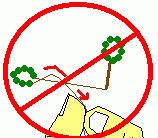








» موسوعة شيلان كروشية بالباترون
» الحروف العربية ( الأبجدية ) مع الصور للتلوين
» أكثر من 30 رسمة للتلوين لغرس السلوكيات الإسلامية
» نمي مهارات طفلك الحسابية واليدوية مع لعبة وصل الأرقام واكتشف الصورة
» كتيب اعمال يدويةو فنية للاطفال
» موسوعة كوفيات الكروشية (crochet scarfs ) بالباترون
» لعبة وصل الأرقام واكتشف الصورة لتنمية ذكاء الاطفال
» جاكيت طويل شتوي بالكروشية مع الباترون
» علب مناديل بالخرز 3 موديلات بالباترون
» توب كله انوووووووووووثه من عمل ايديك
» 6 مفارش كروشية مستديرة وخطيرة بالباترون
» من بنطلون قديم وتيشرت اعملي توب راااااائع كله انوووووثه
» 4 وحدات يعملوا جيليه رووووووعة بالكروشية مع الباترون
» جيليه يضفي على ملابسك شياااااااااكة كروشية بالباترون
» باليرو ررررررررررررررقة كروشية بالباترون
» الأرقام الانجليزية من ( 1 - 10 ) للتلوين
» 4 مفارش ايتامين لها حواف كروشية خطيرررررررة بالباترون
» موسوعة وحدات كروشية على شكل أدوات مطبخ بالباترون
» شنطة حلوووووة من تيشيرت قديم
» تفنني بخياطه فستان ناعم لنفسك بدون باترون والطريقة بالفيديو
» خياطة تنورة قصيرة بكرانيش بدون باترون آخر انوووووثة ( فيديو )
» من بوكسر زوجك اعملي تنورة امووووووووورة
» التيشيرت الساحر فصلي منه 10 موديلات منتهى البساطة
» لون وتعلم المحافظة على آداب الطعام